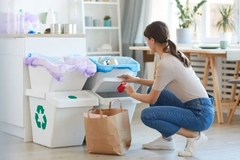Spotlight on additives: Plant-based, antimicrobial and recyclability innovation enhance food-grade plastics

05 Mar 2021 --- Plastic food packaging is only as useful as the additives it contains. Additives are complex blends of materials integrated into plastic polymers to enhance the safety, shape, color, shelf appeal, shelf life and environmental sustainability of packaging.
In FMCG industries, growing demand for more environmentally responsible and hygienic packaging is spurring wide-ranging innovation in additives, from plant-based alternatives to antimicrobial technologies and more conventional options reimagined for the circular economy.
PackagingInsights explores the latest additives innovation with plant-based pioneer Palsgaard, antimicrobial specialist BioCote, and chemical giants BASF, Clariant and Lanxess.
Plant-based power
Danish food emulsifier specialist Palsgaard is facilitating the trend away from fossil materials to renewable alternatives with its plant-based Einar range of anti-stats, anti-fogs, surfactants and modifiers for food-grade polymers.
“The drive for more natural materials is coming from consumers and their increased concern about food safety,” explains Ulrik Aunskjær, global industry director non-food business development, polymer additives at Palsgaard.
“We especially see increased interest in polyolefin foams, as these are to some extent replacing EPS in fast-food containers, which is banned as part of the EU Single Use Plastics Directive.”
Palsgaard offers its anti-fog and anti-static additives in several grades, tailored to film, injection molding, foam and coating processes, for a wide range of different polymers, from polyolefins and PVC to PET.
For polyolefin foams, the company’s additives provide an anti-static effect for easier handling and a clean surface and aging modifiers to facilitate the exchange of blowing agents and air after production.
Like the company’s food ingredients, Einar additives are based on vegetable oils – mainly sunflower, rapeseed and palm. They are produced in CO2-neutral facilities and do not affect polymer recyclability.
Inherent food safety
Many fossil-based additives are restricted in their application uses as they are hazardous in higher concentrations, Aunskjær adds. However, Palsgaard’s polymer additives are safe to eat, and due to this inherent food safety, they do not have specific migration limits like their fossil counterparts.
 Palsgaard recently expanded its Einar capacity with a 10,000-ton pellet line to meet fast-growing demand.“This means in a packaged ice cream, you can find Palsgaard’s products in the polymer where it serves as an anti-static or mold release additive, and in the ice cream where it ensures a creamy mouthfeel, prevention of heat-shock, and good meltdown properties,” he explains.
Palsgaard recently expanded its Einar capacity with a 10,000-ton pellet line to meet fast-growing demand.“This means in a packaged ice cream, you can find Palsgaard’s products in the polymer where it serves as an anti-static or mold release additive, and in the ice cream where it ensures a creamy mouthfeel, prevention of heat-shock, and good meltdown properties,” he explains.
Additionally, the Einar range’s anti-static products help dissipate static charge, keeping the packaging surface dust-free. “The anti-static effect is essential in food packaging manufacturing but also when displayed in, for example, supermarkets, as the additive ensures dust is not attracted to the packed item,” Aunskjær describes.
“The anti-fog additive is mainly used in food packaging films. Again, think of a meat pack or lettuce bag in a cold supermarket environment. The anti-fog ensures the food is visible and also prevents the formation of water droplets on the packaging’s inside.”
Bioplastic boosters
Bioplastics continue to expand in market share and sophistication, with European Bioplastics and the nova-Institute estimating 36 percent growth over the next five years, opening new avenues for the Einar range.
“We are experiencing an increased demand from customers working with biopolymers as our products are plant-based and produced in CO2-neutral factories,” continues Aunskjær.
Einar products are mainly based on glycerol or polyglycerol ester chemistry, meaning the chemical build-up is similar to bio-based polyesters such as PHA, PLA and PEF, and also regular polyesters like PET.
“We have a few products suitable for [bioplastic] applications, such as our slip additive, which can be used internally as it has been synthesized in a way that makes it non-reactive,” Aunskjær highlights.
Additionally, the anti-static and anti-fog coatings developed for external application on PET are ideal for bioplastics, he adds.
Heightened hygiene
Consumer hygiene concern has heightened amid the COVID-19 pandemic. An Innova Market Insights survey found 59 percent of global consumers believe packaging’s protective function is more important since the virus outbreak (2021).
The market researcher identified “Hygiene Heroics” as one of its top packaging trends for 2021, pinpointing the rise of antimicrobial technologies. BioCote is the only antimicrobial additives supplier to be HACCP International certified, meaning its technology is safe for food contact surfaces.
BioCote is the only antimicrobial additives supplier to be HACCP International certified, meaning its technology is safe for food contact surfaces.
“Over the past year, people have become more aware that everyday objects can harbor microbes. In the past, discussions on how clean products are would have sparked limited interest beyond the community directly engaged in this market,” says Megan Vaughan, technical manager at BioCote.
“However, in the current climate, strategies aimed at reducing microbial contamination, such as regular cleaning and hand hygiene, have become an immediate priority for many around the globe, meaning consumers are proactively engaged with ways to improve hygiene standards.”
“There has also been a dramatic rise in the demand for antimicrobial* additives, which provide permanent protection for those products against the growth of a wide range of microbes that can cause odors, staining and material degradation.”
“While antimicrobial additives do not replace the need to clean, they support existing hygiene measures in consumer products.”
BioCote is a leader in innovative antimicrobial applications, assisting businesses in pursuing enhanced product hygiene in the food manufacturing industry.
Antimicrobial innovation
BioCote’s antimicrobial additives are introduced during the manufacturing process, making surfaces inhospitable to microbes, for example, by causing protein, cell membrane and oxidative damage, and through DNA interference.
“Our technology will provide a permanent, non-harmful surface protection for improved hygiene to a wide range of products, ideal for use in food-related environments,” Vaughan explains.
“Less microbes on the surface mean less odors, less staining and reduced material degradation. For some products, this will mean extending its usable lifetime past an unprotected one, creating additional sustainability.”
BioCote antimicrobial additives contain active substances, such as silver, and have been shown to reduce microbes by up to 99.99 percent within a 24-hour period. The company is the only antimicrobial additives supplier to be HACCP International certified, meaning the technology is safe for manufacture into food contact surfaces.
“Our silver-based additives are considered to be non-leaching to the environment and expected to last for the product’s expected lifetime. BioCote protected products often have longer durability than non-treated products due to a reduction in microbial degradation,” adds Vaughan. BASF’s Daniel Santoro, lab technician at the Application Center for Plastic Additives in Switzerland, compares the optical properties of a recycled film with and without a stabilizer package.
BASF’s Daniel Santoro, lab technician at the Application Center for Plastic Additives in Switzerland, compares the optical properties of a recycled film with and without a stabilizer package.
The company’s powder and masterbatch additives do not affect the overall structure of the polymer and are designed to have antimicrobial efficacy at low dosage rates, meaning there is no interference with polymer recyclability.
Moreover, the antimicrobial technology integrates into the packaging without changing its visual appearance.
Recyclability enhancement
A circular economy for plastics packaging is a crucial industry goal amid increasingly stringent regulations, like the EU and UK plastic taxes. According to a study by consulting firm Conversio, around 250 million metric tons of plastic waste is generated globally per year and only 20 percent recycled.
In light of this, BASF researchers are working on ways to close material loops more efficiently using additives.
“Plastics – with unique characteristics and when used properly – contribute to a more sustainable and resource-efficient future,” notes Lilian Hoh, BASF’s communications manager for plastic additives in Europe.
“However, more plastic waste needs to be recovered and reused to move toward a circular economy. Currently, recycled plastic loses its mechanical performance properties and quality compared to virgin plastic due to polymer degradation and residual impurities.”
“In mechanical recycling, waste plastics are shredded and melted to make recyclate, which is then used to make new products. However, this material is not suitable for many applications without further processing.”
Repeated use and processing often damage polymer chains, making the plastic brittle or yellowed, explains Hoh. Also, plastic waste is usually made up of a mixture of different plastic types, inseparable from each other. Clariant’s AddWorks PKG 906 Circle special polymer stabilizer enhances the scrap reuse rate in polyolefin films.
Clariant’s AddWorks PKG 906 Circle special polymer stabilizer enhances the scrap reuse rate in polyolefin films.
“For example, beverage bottles are made of PET while their lids are usually made of polypropylene (PP). Such mixtures of incompatible plastics have a significantly negative impact on quality.”
BASF researchers are addressing these problems by developing plastic additives to stabilize and improve the quality of recycled materials. Solutions – such as compatibilizers – enhance the mechanical properties of polymer mixtures, upgrading mechanically recycled plastics.
Scrap no more
Meanwhile, Clariant has created AddWorks PKG 906 Circle – a special polymer stabilizer to boost the scrap reuse rate in polyolefin films substantially. The production of plastic films for cookies, pasta and other foods generates a lot of scrap, but only a fraction can typically be reused.
The problem is the scrap material is heated during production, degrading the polymer chains. If too much of this post-manufacturing waste is added to virgin resin, the mixture will no longer flow properly. It can also develop gel streaks, black spots or break at high line speeds and yellow tinge in the final product.
Clariant’s stabilizer additive minimizes these effects, enabling reintroducing reground scrap at a rate of 20 percent or more into virgin PP and polyethylene (PE) resins without notable loss in quality or process efficiency. The additive consists of free-flowing white granules, approved for food contact.
“As sustainability is a key pillar of Clariant’s strategy, our current R&D focus is around non-food-competing, sustainable dispersants and lubricants. Our Performance Additives and Flame Retardants teams have also developed additives from sustainable sources, and this will continue,” details Frank Neuber, regional segment manager plastics at Clariant’s Business Unit Additives.
“The masterbatches, compounders and major original equipment manufacturers are asking for products that help with recycling, namely polymer and filler compatibilizers, stabilizers to protect the integrity of the final products from the extra heat histories, and viscosity modifiers to make recycled plastics flow as well, or even better than, legacy compounds and polymers.” Lanxess’ Ultramoll VII additive is a non-phthalate plasticizer specially developed food applications like cling films.
Lanxess’ Ultramoll VII additive is a non-phthalate plasticizer specially developed food applications like cling films.
High migration resistance
While there are always new trends in packaging materials and related additives, demand for existing polymer systems remains high, according to Dr. Thomas Facklam, head of global application technology, Business Unit Polymer Additives at Lanxess.
“We continue to see demand for traditional solutions. We want to promote polymeric additives that are easier to process while maintaining the higher resistance to migration in Europe, such as the new Ultramoll VII.”
The Ultramoll VII additive is a non-phthalate plasticizer specially developed food applications like cling films. The product range boasts optimized processing behavior and improved compatibility in PVC, showing reduced exudation, especially in humid environments.
The polymeric plasticizers vary in viscosity and have different average chain lengths, allowing for diverse applications and focus on processing conditions or migration behavior.
“New products and solutions are constantly being developed – tailored to customer’s individual needs. Our customers also benefit from our global purchasing network, ensuring sustainable access to the required raw materials, not least through our backward integration,” Facklam concludes.
By Joshua Poole
*BioCote technology does not protect users or others against disease-causing bacteria, germs, viruses or other harmful organisms. This technology is not a substitute for good hygiene and/or cleaning practices.











